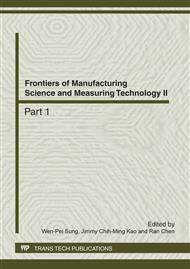[1]
Lu Xiaolan, Huang Lipei, Yang Zhongqing. Current situation and development of Photovoltaic Industry in China [J]. High-tech and industrialization, 2009, 2: 86-88(in Chinese).
Google Scholar
[2]
Elminir H K, Ghitas A E, Hamid R H, et al. Effect of dust on the transparent cover of solar collectors [J]. Energy Conversion Management, 2006, 47: 3192-3203.
DOI: 10.1016/j.enconman.2006.02.014
Google Scholar
[3]
Mazumdera M K, Sharmaa R, Birisa A S, et al. Self-cleaning transparent dust shields for protecting solar panels and other devices[J]. Particulate Science and Technology, 2007, 25: 5-20.
DOI: 10.1080/02726350601146341
Google Scholar
[4]
Gaier J, Davis P, Marabito M. Aeolian removal of dust types from photovoltaic surfaces on Mars[C]/16th AIAA/NASA/ASTM/IES Space Simulation Conference. NM: Albuquerque, (1990).
Google Scholar
[5]
Williams R B, Tanimoto R, Simonyan A, et al. Vibration characterization of self-cleaning solar panels with piezoceramic actuation[C]. Collection of Technical Papers - 48th AIAA/ASME/ASCE/AHS/ASC Structures, Structural Dynamics, and Materials Conference , P 512-520, (2007).
DOI: 10.2514/6.2007-1746
Google Scholar
[6]
Park Y B, Im H, Im M, et al. Self-cleaning effect of highly water-repellent microshell structures for solar cell applications[J]. Journal of Materials Chemistry, 2011, 21: 633–636.
DOI: 10.1039/c0jm02463e
Google Scholar
[7]
Masuda S, Aoyoma M. Characteristics of electric dust collector based on electric curtain[C] / / Proceedings of the General Conference of the Institute of Electronic Engineers. Japan, 1971, No. 821 Proc. of Albany Conference on Electrostatics (1971).
Google Scholar
[8]
Calle C I, Buhler C R, McFall J L, et al. Particle removal by electrostatic and dielectrophoretic forces for dust control during lunar exploration missions[J]. Journal of Electrostatics, 2009 (67): 89–92.
DOI: 10.1016/j.elstat.2009.02.012
Google Scholar
[9]
Atten P, Pang Hai Long, and Reboud J L. Study of dust removal by standing-wave electric curtain for application to solar cells on mars[J]. IEEE Transactions on Industry Applications, 2009, 45(1): 75-86.
DOI: 10.1109/tia.2008.2009723
Google Scholar
[10]
Sharma R, Wyatt C A, Zhang Jing, et al. Experimental evaluation and analysis of electrodynamic screen as dust mitigation technology for future Mars missions[J]. IEEE Transactions on Industry Applications, 2009, 45( 2): 591-596.
DOI: 10.1109/tia.2009.2013542
Google Scholar
[11]
Liu G Q, Marshall J S. Effect of particle adhesion and interactions on motion by traveling waves on an electric curtain[J]. Journal of Electrostatics, 2010 (68): 179-189.
DOI: 10.1016/j.elstat.2009.12.007
Google Scholar



